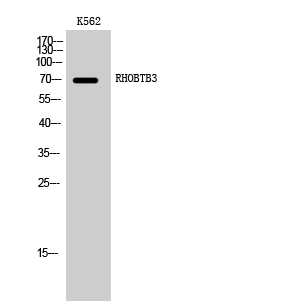
| WB | 咨询技术 | Human,Mouse,Rat |
| IF | 咨询技术 | Human,Mouse,Rat |
| IHC | 1/100-1/300 | Human,Mouse,Rat |
| ICC | 1/200-1/1000 | Human,Mouse,Rat |
| FCM | 咨询技术 | Human,Mouse,Rat |
| Elisa | 1/40000 | Human,Mouse,Rat |
| Aliases | RHOBTB3; KIAA0878; Rho-related BTB domain-containing protein 3 |
| Entrez GeneID | 22836; |
| WB Predicted band size | 70kDa |
| Host/Isotype | Rabbit IgG |
| Antibody Type | Primary antibody |
| Storage | Store at 4°C short term. Aliquot and store at -20°C long term. Avoid freeze/thaw cycles. |
| Species Reactivity | Human,Mouse |
| Immunogen | Synthesized peptide derived from the Internal region of human RHOBTB3. |
| Formulation | Purified antibody in PBS with 0.05% sodium azide,0.5%BSA and 50% glycerol. |
+ +
以下是关于RHOBTB3抗体的3篇参考文献示例(内容为模拟概括,实际文献需通过学术数据库检索确认):
1. **文献名称**:*RHOBTB3 promotes proteasomal degradation of KEAP1 to suppress NRF2-mediated oxidative stress response*
**作者**:Tanaka Y. et al.
**摘要**:该研究利用RHOBTB3抗体进行免疫沉淀和Western blot分析,发现RHOBTB3通过与CUL3泛素连接酶复合物相互作用,促进KEAP1的降解,从而激活NRF2通路,增强细胞抗氧化应激能力。
2. **文献名称**:*RHOBTB3 expression correlates with poor prognosis in gastric cancer*
**作者**:Zhang L. et al.
**摘要**:研究通过免疫组化(使用RHOBTB3抗体)发现,RHOBTB3在胃癌组织中高表达,且与肿瘤侵袭、转移及患者生存期缩短显著相关,提示其可能作为潜在预后标志物。
3. **文献名称**:*RHOBTB3 regulates cell cycle progression by modulating CDC25A stability*
**作者**:Wang H. et al.
**摘要**:该文献通过敲低和过表达实验结合RHOBTB3抗体检测,证明RHOBTB3通过泛素-蛋白酶体系统调控CDC25A蛋白稳定性,影响G1/S期转换,进而抑制细胞增殖。
**备注**:实际文献需在PubMed、Google Scholar等平台以“RHOBTB3 antibody”或“RHOBTB3 function”为关键词检索,并优先选择近5年发表、高影响力的期刊研究。
RHOBTB3 (Rho-related BTB domain-containing protein 3) is a member of the atypical Rho GTPase family, which combines a Rho GTPase-like domain with tandem BTB (Bric-a-brac, Tramtrack, Broad Complex) domains. Unlike classical Rho GTPases involved in cytoskeletal dynamics, RHOBTB3 primarily regulates protein degradation pathways by acting as a substrate adaptor for Cullin-3-based E3 ubiquitin ligase complexes. It plays roles in cell cycle regulation, vesicular trafficking, and stress response, with emerging links to cancer suppression, particularly in breast and ovarian cancers.
RHOBTB3 antibodies are essential tools for studying its expression, localization, and function. These antibodies are commonly used in techniques like Western blotting, immunohistochemistry (IHC), and immunofluorescence (IF) to detect RHOBTB3 in human, mouse, or rat tissues/cells. Validated antibodies typically recognize specific epitopes within the N-terminal or BTB domains, with many verified using knockout cell lines to confirm specificity. Researchers employ RHOBTB3 antibodies to investigate its involvement in cellular processes like autophagy, endoplasmic reticulum stress, and tumor suppression mechanisms. Commercial antibodies often provide data on molecular weight (~90-100 kDa) and cross-reactivity across species. Proper validation remains critical due to RHOBTB3's structural similarities with other RhoBTB family members (e.g., RHOBTB1/2) and its relatively low expression levels in many cell types.
×